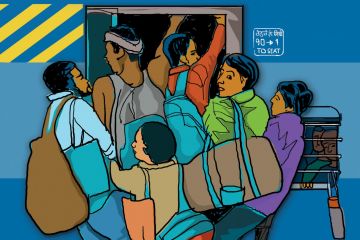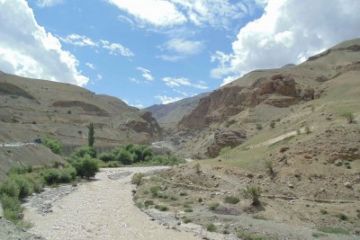
On February 15, 2022, the district administration and the police arrived to demarcate a sand mine on Morhar river in Arhatpur village, about 50 kilometres from where the Buddha attained enlightenment in Bihar.
When the residents of the village protested, the police fired tear gas into the crowd, and beat up men and women. Among the 10 arrested were five women and a minor girl. The police handcuffed them with pieces of their own clothes. They also beat up (but did not arrest) a disabled woman in her 50s.
The police say that they used force in response to the residents attacking the officials.
The six women, out on bail, spoke about the arrest and why they are opposed to sand mining.
Their opposition stems from fear. The government is creating a new ghat (mine), where none existed in the past. This ignited the fear of the residents that the government was siding with sand miners who wanted to profit at the cost of lives and livelihoods in this village.
The women fear that sand mining will affect availability of groundwater, submerge their farm lands and reduce crop production. It will eventually change the course of the river and wash away the village.
It doesn’t help the case that the miners are upper caste Bhumihars from a neighbouring village and Arhatpur is dominated by a Yadav population, a caste that sits in the middle of the caste hierarchy and is categorised by the government as an Other Backward Caste.
Sand miners aren’t here just to make money, says Geeta Devi, one of the six arrested women. “They are here to finish us.”
Rampant, and often illegal, sand mining has ruined several rivers of Bihar. It has destroyed agricultural lands, washed away homes and killed people. Women bear a disproportionate burden of this impact. While the women of Arhatpur are up against the system, mothers living on the banks of the Sone river in central Bihar mourn the loss of their young sons privately. The young men were killed while working on several legal and illegal mines operating independently of each other along the river.
The victims, daily wage workers, often come from disadvantaged castes and are often landless. For them, working in sand mining is the only work available. But these jobs are dangerous. At least 76 people lost their lives and 103 were injured in sand mining related accidents and violence between December 2020 and March 2022 in Bihar, according to a report from South Asia Network on Dams, Rivers and People.
The most common reason for workers’ death is when sand-laden boats capsize, especially during the monsoon when the river is full and boats are overloaded. In October 2022, five labourers were feared drowned as a sand laden boat sank in the Ganges. At least 14 labourers went missing and were feared dead when a sand boat capsized in the Ganges in September 2021. At least 20 sand workers drowned in two incidents of sand boats capsizing in August 2021 and September 2021 in Chhapra.
There are several other deaths reported, when labourers get buried under piles of sand, after they dig a deep pit. In July 2022, one labourer died and six were injured, when huge chunks of sand fell on them during illegal mining operations near Patna. Within a week, in Saran, two workers died and another was injured in a similar accident.
Many workers also die while driving sand-laden tractor-trolleys out of mines. As tractors, heavy with loaded trolleys, attempt to climb out of steep sand pits, the engines topple over and crush the driver. Two mothers spoke about losing their teenage sons in such freak accidents.
Radhika Devi, a resident of Semaria village on the bank of the Sone river, wonders if her son would have survived if he didn’t return home when his school shut during the Covid-19 pandemic. “He was studying to get a good job and support us in our old age,” she says. “But that was not to be.”
Traffic accidents caused by rashly driven sand vehicles are another reason for deaths. Kamli Devi’s village Narayanpur has at least 20 sand mines operating within a 5km radius. She lost her 22-year-old son, Ankit Kumar, on 5 December 2020 when a sand-laden truck ran him over. The truck driver fled the scene and was never caught, says Kamli Devi.
The illegal sand industry has left the region full of unsupported parents. But the irony is that many young men work in the sand business to provide for their parents.
Take the case of Kanti Devi, who lives at Haldi Chhapra, where the Sone meets the Ganges. She lost her 23-year-old son, Rajan Paswan, in a cooking gas explosion aboard a sand-laden boat, on August 6, 2022. He was a Mahadalit, the state government’s term to categorise the most marginalised among the oppressed castes.
But her younger son, Anand, continues to work in sand mining. He says this is the only job available here. “How am I going to look after my old parents? I have to work in the mines to support them,” he says.
“Even if it means I might die doing it.”
(This article was produced in partnership with the Environmental Reporting Collective.)
This story is the third and final part in a series on illegal sand mining in Bihar.






